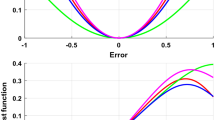Abstract
The paper shows the possibility of representing a recurrent \(P\)-spline in the form of a spline adaptive filter (SAF) with an infinite impulse response and variable operating parameters. A spline adaptive filter consists of a linear dynamic part and a nonlinear static part. To configure the parameters, computational schemes have been created, and their choice determines the method of adapting the nodes and the formula for the spline coefficients. Elimination of optimization search procedures provides low computational costs of the suggested calculation scheme construction.








Similar content being viewed by others
REFERENCES
A. H. Sayed, Adaptive Filters (Wiley-IEEE Press, 2011). https://doi.org/10.1002/9780470374122
Adaptive Learning Methods for Nonlinear System Modeling, Ed. by D. Comminiello and J. C. Príncipe (Elsevier, Oxford, 2018). https://doi.org/10.1016/C2016-0-04159-1
M. A. Shcherbakov and A. P. Panov, ‘‘Nonlinear filtering with adaptation to local properties of the image,’’ Komp’yuternaya Opt. 38, 818–824 (2014). https://doi.org/10.18287/0134-2452-2014-38-4-818-824
Y. R. Wang and C. M. Cheng, ‘‘Volterra series identification and its applications in structural identification of nonlinear block-oriented systems,’’ Int. J. Syst. Sci. 51, 1959–1968 (2020). https://doi.org/10.1080/00207721.2020.1781289
E. B. Solovyeva, ‘‘Behavioural nonlinear system models specified by various types of neural networks,’’ J. Phys.: Conf. Ser. 1015, 032139 (2018). https://doi.org/10.1088/1742-6596/1015/3/032139
K. Fallahi, R. Raoufi, and H. Khoshbin, ‘‘An application of Chen system for secure chaotic communication based on extended Kalman filter and multi-shift cipher algorithm,’’ Commun. Nonlinear Sci. Numer. Simul. 13, 763–781 (2008). https://doi.org/10.1016/j.cnsns.2006.07.006
W. Liu, J. C. Principe, and S. Haykin, Kernel Adaptive Filtering: A Comprehensive Introduction (Wiley, 2010). https://doi.org/10.1002/9780470608593
D. Comminiello, M. Scarpiniti, L. A. Azpicueta-Ruiz, J. Arenas-Garcia, and A. Uncini, ‘‘Functional link adaptive filters for nonlinear acoustic echo cancellation,’’ IEEE Trans. Audio, Speech, Lang. Process. 21, 1502–1512 (2013). https://doi.org/10.1109/tasl.2013.2255276
M. Scarpiniti, D. Comminiello, R. Parisi, and A. Uncini, ‘‘Nonlinear spline adaptive filtering,’’ Signal Process. 93, 772–783 (2013). https://doi.org/10.1016/j.sigpro.2012.09.021
Block-Oriented Nonlinear System Identification, Ed. by F. Giri and E. W. Bai, Lecture Notes in Control and Information Sciences, Vol. 404 (Springer, Berlin, 2010). https://doi.org/10.1007/978-1-84996-513-2
S. Cheng, Yi. Wei, D. Sheng, and Yo. Wang, ‘‘Identification for Hammerstein nonlinear systems based on universal spline fractional order LMS algorithm,’’ Commun. Nonlinear Sci. Numer. Simul. 79, 104901 (2019). https://doi.org/10.1016/j.cnsns.2019.104901
M. Scarpiniti, D. Comminiello, R. Parisi, and A. Uncini, ‘‘Spline adaptive filters,’’ in Adaptive Learning Methods for Nonlinear System Modeling, Ed. by D. Comminiello and J. C. Príncipe (Butterworth-Heinemann, London, 2018), pp. 47–69. https://doi.org/10.1016/b978-0-12-812976-0.00004-x
M. Scarpiniti, D. Comminiello, R. Parisi, and A. Uncini, ‘‘Nonlinear system identification using IIR spline adaptive filters,’’ Signal Process. 108, 30–35 (2015). https://doi.org/10.1016/j.sigpro.2014.08.045
V. Patel and N. V. George, ‘‘Multi-channel spline adaptive filters for non-linear active noise control,’’ Appl. Acoust. 161, 107142 (2020). https://doi.org/10.1016/j.apacoust.2019.107142
S. Peng, Z. Wu, X. Zhang, and B. Chen, ‘‘Nonlinear spline adaptive filtering under maximum correntropy criterion,’’ in TENCON 2015-2015 IEEE Region 10 Conf., Macao, China, 2016 (IEEE, 2016), pp. 1–5. https://doi.org/10.1109/TENCON.2015.7373051
C. Liu, Z. Zhang, and X. Tang, ‘‘Sign-normalized IIR spline adaptive filtering algorithms for impulsive noise environments,’’ Circuits, Syst., Signal Process. 38, 891–903 (2019). https://doi.org/10.1007/s00034-018-0874-9
T. Yu, W. Li, Yi. Yu, and R. C. de Lamare, ‘‘Robust spline adaptive filtering based on accelerated gradient learning: Design and performance analysis,’’ Signal Process. 183, 107965 (2021). https://doi.org/10.1016/j.sigpro.2021.107965
L. Yang, J. Liu, Z. Zhao, R. Yan, and X. Chen, ‘‘Interval variable step-size spline adaptive filter for the identification of nonlinear block-oriented system,’’ Nonlinear Dyn. 98, 1629–1643 (2019). https://doi.org/10.1007/s11071-019-05243-8
R. Sameni, ‘‘Online filtering using piecewise smoothness priors: Application to normal and abnormal electrocardiogram denoising,’’ Signal Process. 133, 52–63 (2017). https://doi.org/10.1016/j.sigpro.2016.10.019
Yu. Wang, Smoothing Splines: Methods and Applications (Chapman and Hall/CRC, New York, 2011). https://doi.org/10.1201/b10954
S. Sharif and S. Kamal, ‘‘Comparison of significant approaches of penalized spline regression (P-splines),’’ Pak. J. Stat. Operation Res. 14, 289–303 (2018). https://doi.org/10.18187/pjsor.v14i2.1948
G. Budakçı, Ç. Dişibüyük, R. Goldman, and H. Oruç, ‘‘Extending fundamental formulas from classical B-splines to quantum B-splines,’’ J. computational applied mathematics 282, 17–33 (2015).
H. Idais, M. Yasin, M. Pasadas, and P. González, ‘‘Optimal knots allocation in the cubic and bicubic spline interpolation problems,’’ Math. Comput. Simul. 164, 131–145 (2019). https://doi.org/10.1016/j.matcom.2018.11.002
L. Tan and J. Jiang, Digital Signal Processing: Fundamentals and Applications (Academic, 2019). https://doi.org/10.1016/C2017-0-02319-4
E. A. Kochegurova and E. S. Gorokhova, ‘‘Current estimation of the derivative of a nonstationary process based on a recurrent smoothing spline,’’ Optoelectron., Instrum. Data Process. 52, 280–285 (2016). https://doi.org/10.3103/S8756699016030109
E. A. Kochegurova, A. I. Kochegurov, and N. E. Rozhkova, ‘‘Frequency analysis of recurrence variational P-splines,’’ Optoelectron., Instrum. Data Process. 53, 591–598 (2017). https://doi.org/10.3103/S8756699017060085
L. Yang, J. Liu, R. Sun, R. Yan, and X. Chen, ‘‘Spline adaptive filters based on real-time over-sampling strategy for nonlinear system identification,’’ Nonlinear Dyn. 103, 657–675 (2021). https://doi.org/10.1007/s11071-020-05899-7
S. K. Saha, R. Kar, D. Mandal, and S. P. Ghoshal, ‘‘Optimal IIR filter design using gravitational search algorithm with wavelet mutation,’’ J. King Saud Univ. Comput. Inf. Sci. 27, 25–39 (2015). https://doi.org/10.1016/j.jksuci.2014.03.002
S. S. Bhattacharjee, V. Patel, and N. V. George, ‘‘Nonlinear spline adaptive filters based on a low rank approximation,’’ Signal Process. 201, 108726 (2022). https://doi.org/10.1016/j.sigpro.2022.108726
E. A. Kochegurova and D. Wu, ‘‘Realization of a recursive digital filter based on penalized splines,’’ Comput. Opt. 42, 1083–1092 (2018). https://doi.org/10.18287/2412-6179-2018-42-6-1083-1092
M. Rathod, V. Patel, and N. V. George, ‘‘Generalized spline nonlinear adaptive filters,’’ Expert Syst. Appl. 83, 122–130 (2017). https://doi.org/10.1016/j.eswa.2017.04.043
T. Krivobokova, C. M. Crainiceanu, and G. Kauermann, ‘‘Fast adaptive penalized splines,’’ J. Comput. Graphical Stat. 17, 1–20 (2008). https://doi.org/10.1198/106186008x287328
L. Yang and Yo. Hong, ‘‘Adaptive penalized splines for data smoothing,’’ Comput. Stat. Data Anal. 108, 70–83 (2017). https://doi.org/10.1016/j.csda.2016.10.022
Funding
The work was supported by the Russian Science Foundation (project no. 23-21-00259).
Author information
Authors and Affiliations
Corresponding author
Ethics declarations
The authors of this work declare that they have no conflicts of interest.
Additional information
Publisher’s Note.
Allerton Press remains neutral with regard to jurisdictional claims in published maps and institutional affiliations.
Translated by L. Trubitsyna
About this article
Cite this article
Kochegurova, E.A., Martynova, Y.A. Real-Time Spline Adaptive Filter: Design and Efficiency Analysis. Optoelectron.Instrument.Proc. 59, 569–579 (2023). https://doi.org/10.3103/S875669902305014X
Received:
Revised:
Accepted:
Published:
Issue Date:
DOI: https://doi.org/10.3103/S875669902305014X




